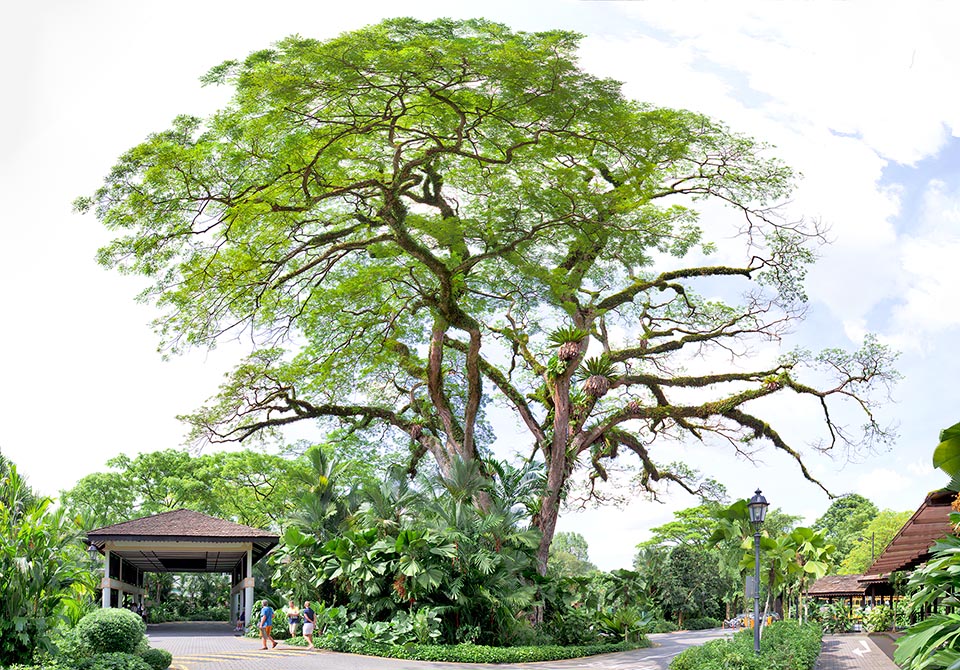Family : Fabaceae

Text © Pietro Puccio

English translation by Mario Beltramini
The species is native to Colombia, Costa Rica, El Salvador, Nicaragua, Panama and Venezuela, where it grows in the savannas and in the deciduous forests, from the sea level up to about 700 m of altitude.
The genus is honoured to the Italian nobleman Filippo degli Albizi who in 1749 carried from Constantinople to Florence the Albizia julibrissin; the name of the species is the one used by the local populations of northern Venezuela.
Common names: cow tamarind, east Indian walnut, Fench tamarind, friendly tree, kindly tre, monkey pod, rain tree, saman tree (English); biliti siris (Bengali); arbre à la pluie, saman (French); gulabi siris, vilaiti siris (Hindi); bordão de velho, chorona, ingá-de-pobre (Portuguese – Brazil); acacia preta, algarrobo, árbor de la lluvia, campano, carabeli, carreto, cenìzaro, couji, dormilón, lara, samán, urero, zamán (Spanish); amaivagai, thoongumoonji maram (Tamil); cham cha, kam kram (Thai); còng (Vietnamese).
The Albizia saman (Jacq.) Merr. (1876) is an unarmed tree, evergreen or deciduous for a short time, 12-25 m tall, with an ample umbrella-like crown, trunk of more than one m of diameter, with greyish, wrinkly bark, from which exudes a brown gum, and young pubescent branches; like in other Fabaceae the rooting apparatus is able to fix the atmospheric nitrogen enriching the soil with it. Alternate leaves with an enlargement at the base of the petiole (pulvinus), bipinnate, 15-30 cm long with 2-6 pairs of pinnate leaflets, 5-7 cm long, formed by 3-8 pars of asymmetric ovate-oblong sessile leaflets with obtuse apex, glossy green on the upper page, covered by thick whitish tomentum below, 2-5 cm long and 1-3 cm broad, of size increasing from the base to the apex; the leaflets close at night and in the cloudy or rainy days. Inflorescences in dense globose capitula of about 5 cm of diameter, on an about 6 cm long pubescent peduncle, solitary or 2-3 together at the axil of the upper leaves, carrying 12-25 flowers with green funnel-shaped calyx with five teeth, 0,5 cm long, funnel-shaped corolla with five lobes, pinkish, 1,2-1,6 cm long, and 3-4 cm long filaments, white in the lower half, pink in the upper one, merged at the base in an about 1 cm long tube; at the centre of each capitulum stands a flower bigger than the others, rich of nectar, which has the duty of attracting the pollinating insects.

The Albizia saman can be 25 m tall with an ample crown of great ornamental and landscape value. Here the legendary specimen of "rain tree" at main entrance to Singapore Botanical Garden that has given name to the accessing rain tree road. The prized wood resists to rottenness and to xylophagous insects © Giuseppe Mazza
It reproduces by seed, previously scarified to notch the waxy water-repellent coating or immersed in water at 80 °C for 2 minutes and then in water at ambient temperature for one day, in organic loam with addition of coarse siliceous sand for a 30% at the temperature of 22-24 °C, with germination times of 3-5 days.
Species of very high ornamental and scenic value, for the imposing crown, the elegant leaves and the abundant blooming, has rapidly diffused in all tropical countries as shade tree in parks, large gardens and along wide boulevards, thanks also to the fast growth and the adaptability to different types of soils, even poor, acidic to alkaline, it bears, furthermore, the transplants and the prunings, even if drastic. Cultivable in full sun exclusively in the tropical and subtropical climate zones, not bearing temperatures of less than 10 °C if not exceptional and for very short period, with regular waterings, where necessary, in the juvenile stage, when adult can stand periods of drought, possibly with the loss of the leaves. Seen its characteristics, is a species particularly suitable for the reforestation.
The tree is also employed for shading the plantations of cocoa, coffee, nutmeg, pepper, vanilla and other crops; the leaves and especially the fruits are used as food for the cattle and from the fermented pulp they get an alcoholic drink.
The wood has excellent characteristics, in particular a very low contraction during the desiccation, is resistant to the rottenness and to the xylophagous insects and is utilized for realizing prized furniture, sculptures and various handicrafts, as well as fuel.
Synonyms: Mimosa saman Jacq. (1800); Inga cinerea Humb. & Bonpl. ex Willd. (1806); Inga saman (Jacq.) Willd. (1806); Mimosa pubifera Poir. (1810); Inga salutaris Kunth (1823); Pithecellobium saman (Jacq.) Benth. (1844); Pithecellobium cinereum (Humb. & Bonpl. ex Willd.) Benth. (1844); Acacia propinqua A.Rich. (1845); Calliandra saman (Jacq.) Griseb. (1860); Albizia saman (Jacq.) F. Muell. (1876); Feuilleea saman (Jacq.) Kuntze (1891); Enterolobium saman (Jacq.) Prai (1897); Zygia saman (Jacq.) Lyons (1907); Samanea saman (Jacq.) Merr. (1916).
→ To appreciate the biodiversity within the family of FABACEAE please click here.
